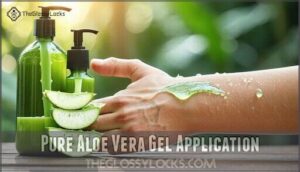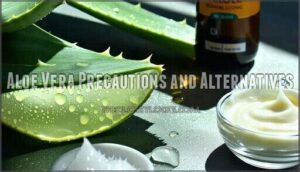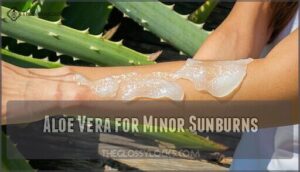This site is supported by our readers. We may earn a commission, at no cost to you, if you purchase through links.

Apply a thin layer of pure aloe vera gel directly from the plant or store-bought gel—skip products with alcohol or fragrances that’ll sting like crazy.
Spread it evenly across affected areas two to three times daily. The gel acts like nature’s cooling balm, reducing inflammation while your skin drinks up the moisture it desperately needs.
Store your aloe gel in the fridge for extra cooling relief that feels like a mini vacation for your scorched skin. But there’s more to maximizing aloe’s healing power.
Table Of Contents
- Key Takeaways
- Aloe Vera Sunburn Relief
- Using Aloe Vera for Sunburn
- Sunburn Causes and Effects
- Aloe Vera Benefits for Sunburn
- Applying Aloe Vera Gel
- Aloe Vera Precautions and Alternatives
- Treating Sunburn With Aloe Vera
- Frequently Asked Questions (FAQs)
- How do you apply aloe vera gel on a sunburn?
- How to apply aloe vera on sunburn blisters?
- How to treat a sunburn with Aloe vera & cucumber?
- Does aloe vera cause sunburn?
- Is aloe vera good for Burns?
- What is the best aloe for sunburn symptoms?
- Can I use aloe vera straight from the plant on a burn?
- Can I use aloe vera straight from the plant?
- How do you use aloe vera after sun?
- What heals sunburn fast?
- Conclusion
Key Takeaways
- Apply pure aloe vera gel directly to sunburned skin – Use 100% pure gel without alcohol or fragrances, spreading a thin layer every 2-3 hours until your skin heals completely.
- Store your aloe vera gel in the refrigerator – The cold temperature provides extra cooling relief that soothes painful, inflamed skin while maintaining the gel’s potency.
- Choose fresh plant gel over store-bought when possible – Fresh aloe vera gel extracted directly from the plant contains more active compounds and delivers better healing results than processed versions.
- Watch for severe burn symptoms that need medical attention – If you have blisters covering large areas, fever, or signs of infection, do not rely on home remedies and seek professional medical care immediately.
Aloe Vera Sunburn Relief
When you’re nursing a painful sunburn that feels like you’ve been grilled at a summer barbecue, aloe vera gel can provide the cooling relief your skin desperately needs.
When your skin feels like it’s been kissed by fire, aloe vera becomes your cooling savior.
This natural remedy, which has been trusted for thousands of years as the "burn plant," contains powerful anti-inflammatory compounds and moisturizing properties that help soothe pain, reduce redness, and speed up your skin’s healing process.
Historical Use of Aloe Vera
Aloe vera’s medicinal origins stretch back thousands of years, earning it the nickname "Ancient Aloe" among healers worldwide.
This tropical medicinal plant found traditional applications across Egypt, Greece, and China for treating burns and wounds.
Through global spread and trade routes, early research confirmed what ancient civilizations knew—aloe vera benefits included remarkable healing properties for damaged skin, with aloe vera being a key component, and its use leading to remarkable healing.
Properties of Aloe Vera
What makes this green wonder so effective for your burning skin?
The plant’s remarkable composition explains its healing power.
Here are five key aloe vera properties that make it nature’s perfect sunburn remedy:
- 75 Active Components – Including vitamins, minerals, and enzymes
- 19 Amino Acids – Building blocks for skin repair
- Anti-Inflammatory compounds – Reduce redness and swelling
- High water content – Provides instant skin hydration
- Collagen boost – Stimulates natural healing
Aloe Vera Application Methods
When choosing between fresh vs. store-bought options, you’ll find both work effectively for sunburn relief.
Extract gel directly from aloe leaves or grab quality store-bought aloe vera gel for convenient application.
Apply a thin layer to affected skin every 2-3 hours, allowing proper absorption time.
Refrigerate your aloe vera application method beforehand for enhanced cooling methods and faster skin sunburn treatment.
Using Aloe Vera for Sunburn
Getting the most from aloe vera sunburn treatment means understanding how this desert plant works its magic on damaged skin.
You’ll want to apply pure aloe vera gel directly to affected areas, letting its proven benefits cool and soothe inflammation.
The aloe source matters—fresh plant gel trumps store-bought versions loaded with additives.
Apply every few hours for maximum sunburn relief, though watch for aloe side-effects like skin irritation.
Aloe vera also contains compounds that inhibit melanin production, potentially helping with sun-induced hyperpigmentation.
While aloe alternatives explored include cool compresses, nothing beats this time-tested aloe vera for skin healing.
Sunburn Causes and Effects
When you spend too much time in the sun without proper protection, UV radiation damages your skin cells and triggers your body’s immune system to release inflammatory proteins that cause the familiar redness, pain, and swelling.
This process doesn’t just create temporary discomfort—it can lead to peeling skin, premature aging, and increases your risk of developing skin cancer later in life.
UV Radiation Damage
Your skin faces a double threat when you’re outside.
UV radiation from the sun penetrates deep into your skin cells, creating havoc at the cellular level through DNA damage and oxidative stress.
Here’s what happens during UVB exposure and UVA impact:
- UVB rays directly damage DNA in skin cells, triggering mutations
- UVA rays create oxidative stress that breaks down cellular structures
- Both types overwhelm your skin’s natural cellular repair mechanisms
Inflammation and Immune Response
When UV rays damage your skin, your immune system kicks into high gear.
When sunburn strikes, your body’s defense system launches into full battle mode against the damage.
Inflammatory proteins flood the area, triggering redness and swelling that makes you wince at every touch.
This UV triggered response sends immune cell activity into overdrive, removing damaged cells while skin repair mechanisms work overtime.
That’s where aloe vera sunburn relief shines—its antiinflammatory properties calm this inflammatory chaos naturally.
Long-term Damage and Skin Cancer Risk
Each sunburn piles on cumulative DNA damage that accelerates premature aging and boosts your skin cancer risk.
Five or more sunburns double your melanoma chances, while just one blistering childhood burn substantially increases lifelong cancer odds.
Your skin cells can’t completely repair this UV exposure damage, making sunburn prevention your best defense against permanent skin damage.
In the UK, a staggering 66% experienced sunburn during childhood, which highlights the importance of skin cancer risk awareness.
Aloe Vera Benefits for Sunburn
When you’re dealing with painful, red sunburned skin, aloe vera offers three key benefits that make it your go-to remedy.
This natural plant extract reduces inflammation while keeping your skin moisturized and providing pain relief as new skin cells regenerate.
Anti-inflammatory Properties
Aloe vera’s anti-inflammatory properties work like nature’s fire extinguisher on your sunburned skin.
The compound aloin tackles inflammation head-on, while hormones auxin and gibberellins provide powerful healing effects.
- Aloin benefits – Reduces redness and swelling naturally
- Auxin action – Promotes rapid cell repair and regeneration
- Gibberellin effects – Minimizes inflammatory response throughout healing
- Inflammation reduction – Calms angry, irritated skin tissue
- Cooling sensation – Provides immediate comfort upon application
Moisturizing and Hydrating Effects
Beyond reducing inflammation, aloe vera’s high water content makes it a natural moisturizer for parched, sunburned skin.
You’ll find that aloe hydration works like a protective barrier, helping with retaining moisture while boosting skin elasticity.
This prevents the intense peeling that often follows sunburn, and the gel’s natural compounds keep your skin soft and supple during the healing process, which is aided by retaining moisture.
Pain Relief and Skin Regeneration
Your body launches an impressive cellular repair mission when aloe compounds get to work.
This natural powerhouse contains 19 essential amino acids that kickstart skin cell regeneration and boost collagen production.
The healing timeline accelerates as aloe vera sunburn treatment reduces scar formation while providing skin sunburn pain relief.
As UV radiation can damage the skin, it’s important to start repairs quickly.
Think of it as nature’s reconstruction crew rebuilding damaged tissue from the inside out, which is a part of the natural powerhouse and involves skin cell regeneration.
Applying Aloe Vera Gel
You’ll get the best results when you apply pure aloe vera gel directly to your sunburned skin, using gentle motions to spread a thin layer across the affected areas.
For maximum cooling relief, store your aloe gel in the refrigerator beforehand, and reapply it two to three times daily until your skin heals completely.
Pure Aloe Vera Gel Application
Getting your hands on 100 percent aloe vera gel makes all the difference for sunburn relief.
Look for pure gel without added colors, fragrances, or alcohol that’ll irritate sensitive skin further.
Apply a thin layer directly to your aloe vera skin, allowing proper gel absorption. You don’t need to slather it on thick—gentle coverage works better for effective aloe vera for skin treatment.
Consider purchasing aloe vera products for the best results.
Aloe Vera Gel Storage and Refrigeration
Proper storage keeps your aloe vera gel fresh and potent for maximum sunburn relief. Temperature effects play a vital role in maintaining gel consistency and therapeutic benefits.
Here’s how to store your aloe vera gel effectively:
- Refrigerate fresh gel – Store homemade aloe vera gel in the fridge for up to one week to preserve its cooling effect
- Use airtight containers – Choose amber glass jars or sealed containers to protect from light and moisture
- Freeze for extended storage duration – Pour gel into ice cube trays for months of preservation
- Keep store-bought gel cool – Refrigeration benefits include enhanced soothing properties for skin sunburn treatment storage
- Check expiration dates – Monitor freshness to guarantee the best healing power for your skin
Aloe vera also contains compounds like Aloin that can lighten skin.
Frequency and Duration of Application
Apply aloe vera gel generously to soothe sunburn, reapplying every 2-3 hours for maximum relief.
Use a thicker layer overnight for deep hydration. Continue this sunburn treatment until redness and pain subside, usually 3-5 days. Don’t overdo it—6 applications daily is plenty.
| Timing | Application | Frequency | Duration |
|---|---|---|---|
| Morning | Thin layer | Every 2-3 hours | 3-5 days |
| Afternoon | Moderate layer | 6 times max daily | Until healed |
| Evening | Thicker layer | Overnight use | Deep hydration |
| Severe Sunburn | Consult doctor | Stop if irritation | Seek medical advice |
Aloe Vera Precautions and Alternatives
While aloe vera works wonders for most sunburns, you’ll want to know when it’s not the right choice and what other remedies can help.
If you’re dealing with severe burns, allergic reactions, or need faster relief, there are important precautions to keep in mind and effective alternatives that can complement or replace aloe vera treatment.
Alternative Remedies for Sunburn
While aloe vera gel works wonders as a natural sunburn remedy, you’ve got other options when your green friend isn’t available.
Organic honey speeds healing and fights infection when applied once daily. You can find organic honey products designed for sunburn relief.
Tea tree oil mixed with a carrier oil creates an effective soothe sunburn treatment. Essential oils like peppermint, chamomile, and lavender offer cooling relief when properly diluted.
These herbal remedies complement aloe vera sunburn treatments, giving you multiple ways to tackle painful, red skin naturally.
Medical Advice for Severe Sunburns
While home remedies work wonders for minor burns, severe sunburns require immediate medical attention. Don’t gamble with your health when facing a medical emergency.
Watch for these severe burn symptoms that signal it’s time to see a doctor:
- Blisters coverage over large skin areas
- Signs of sun poisoning like fever, chills, or nausea
- Third-degree burn indicators including white or charred skin
- Infection risk factors such as pus, increased pain, or red streaking
- Burns on face, hands, feet, or genitals
Hospital burn treatment beats home remedies when dealing with serious damage. Healthcare professionals can assess your situation properly and provide the necessary care to prevent further complications, ensuring the best possible outcome for severe sunburns.
Treating Sunburn With Aloe Vera
When you’re dealing with a painful sunburn, aloe vera can provide the soothing relief your skin desperately needs.
You’ll find that this natural remedy works effectively for minor to moderate sunburns, helping reduce inflammation while keeping your skin moisturized during the healing process.
Aloe Vera for Minor Sunburns
Minor sunburn responds well to gentle aloe vera gel application.
You’ll want to apply a thin layer of pure aloe vera gel three to four times daily for ideal skin sunburn relief methods.
Different aloe vera types work effectively, but choose fragrance-free options for sensitive skin.
Consider purchasing pure aloe for the best results.
Keep your gel refrigerated for enhanced cooling methods – the chill provides extra comfort while the gel thickness creates a protective barrier.
Aloe Vera for Second-degree Burns
Second-degree burn treatment with aloe vera gel delivers impressive healing benefits.
Research shows aloe vera sunburn applications reduce healing time by 4.44 days compared to other treatments.
You’ll experience enhanced skin healing without increased infection risk, and for proper aloe vera dosage, apply pure gel three times daily.
This natural burn treatment supports pain management while promoting tissue regeneration and scarring prevention through its proven therapeutic compounds.
Combining Aloe Vera With Other Remedies
You can boost aloe vera’s healing power by combining it with other natural remedies.
Mix honey and aloe for enhanced antibacterial benefits, or add diluted tea tree oil for extra soothing effects. Essential oils like lavender work well too.
For soothing relief, consider chamomile’s calming properties.
Always do a patch test first before trying new combinations. If your sunburn worsens or shows infection signs, seek medical consultation immediately, and remember to prioritize soothing relief.
Frequently Asked Questions (FAQs)
How do you apply aloe vera gel on a sunburn?
While harsh sunburns scream for relief, gentle aloe vera whispers healing.
Apply cool, pure gel directly to burned skin using clean fingertips.
Spread thin layers, let dry completely, then reapply every few hours for soothing comfort.
How to apply aloe vera on sunburn blisters?
Don’t apply aloe vera directly on sunburn blisters.
Instead, gently dab pure aloe gel around the blistered area without breaking the skin.
Let blisters heal naturally while keeping surrounding skin moisturized and protected.
How to treat a sunburn with Aloe vera & cucumber?
Like nature’s cooling balm meeting crisp garden freshness, you’ll create healing magic by blending fresh aloe gel with cucumber puree.
Gently apply this soothing mixture to sunburned skin twice daily for instant relief and faster recovery.
Does aloe vera cause sunburn?
No, aloe vera doesn’t cause sunburn.
It actually prevents and treats sunburn with its anti-inflammatory properties.
You’re safe using pure aloe vera gel on your skin for soothing relief and healing.
Is aloe vera good for Burns?
Good things come to those who wait, but aloe vera doesn’t make you wait for burn relief.
You’ll find it’s excellent for first- and second-degree burns, soothing pain while promoting healing naturally.
What is the best aloe for sunburn symptoms?
Choose 100% pure aloe vera gel for sunburn relief.
Fresh gel from the plant works best, but store-bought versions are convenient.
Keep it refrigerated for extra cooling power—your skin will thank you later.
Can I use aloe vera straight from the plant on a burn?
Nature’s cooling balm awaits in your backyard garden.
You can absolutely use fresh aloe vera gel directly from the plant on burns.
Simply slice a leaf, extract the clear gel, and apply it gently to soothe your skin.
Can I use aloe vera straight from the plant?
Yes, you can use fresh aloe vera directly from the plant.
Simply cut a leaf, slice it open, and apply the clear gel to your skin.
It’s nature’s remedy straight from the source.
How do you use aloe vera after sun?
Like a cooling balm from nature’s first-aid kit, aloe vera soothes sun-damaged skin beautifully.
Apply fresh gel or store-bought aloe directly to affected areas several times daily, letting it absorb completely for maximum healing benefits.
What heals sunburn fast?
Cool compresses, aloe vera gel, and staying hydrated speed sunburn healing.
Take ibuprofen for inflammation, avoid further sun exposure, and don’t pick peeling skin.
Time’s your best friend—most sunburns heal within a week.
Conclusion
Research shows that aloe vera can reduce sunburn healing time by up to 50% compared to untreated burns.
You’ve now learned how to use aloe vera for sunburn relief effectively—from selecting pure gel to proper application techniques.
Remember to refrigerate your aloe for maximum cooling benefits and apply it consistently throughout your recovery.
With these proven methods, you’ll transform painful sunburn into manageable healing while protecting your skin’s long-term health naturally.
- https://www.ncbi.nlm.nih.gov/pubmed/17499928
- https://my.clevelandclinic.org/health/diseases/21858-sunburn
- https://www.aad.org/public/everyday-care/injured-skin/burns/treat-sunburn
- https://link.springer.com/article/10.1007%2Fs11356-020-08543-4
- http://www.skincancer.org/skin-cancer-information/skin-cancer-facts













